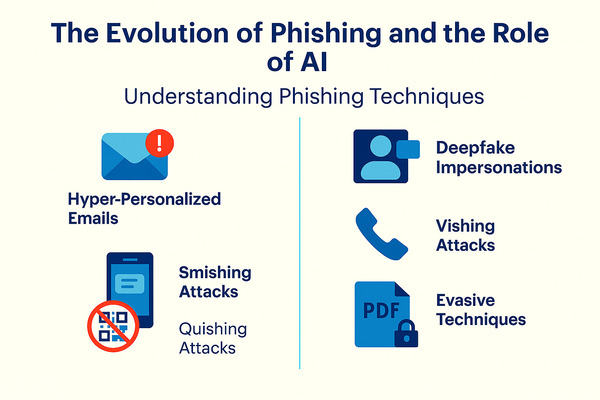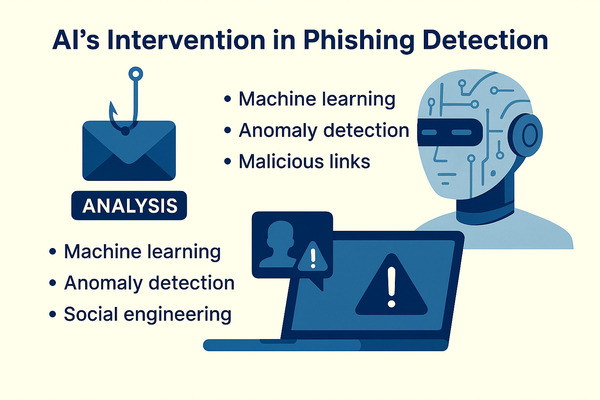You’re receiving more emails than ever before, and unfortunately, so are cybercriminals. In 2025, email users face an evolving threat landscape where traditional security measures struggle to combat sophisticated phishing attacks. The challenge is evident: phishing detection is increasingly difficult as threat actors utilize artificial intelligence to craft malicious emails that bypass conventional filters.
AI phishing detection is a groundbreaking development in email security. It provides organizations and individuals with a robust defense mechanism that matches the complexity of modern threats. By leveraging machine learning models and AI-powered anti-phishing tools, you can safeguard your business data and personal information from increasingly convincing social engineering tactics.
The stakes are higher than ever. Recent reports reveal that over 85% of phishing attacks target credential theft, a figure expected to exceed 90% in the coming year. This highlights the importance of understanding the role of artificial intelligence in email security.
As cybercriminals use AI to create personalized, grammatically precise, and emotionally manipulative phishing content, traditional defenses are becoming less effective. Whether you’re an IT professional or a business leader, recognizing the impact of AI on both phishing tactics and detection is essential to staying ahead of cyber threats.
In this AI Phishing Detection article, we’ll delve into how AI is transforming email security, the technologies driving next-generation threat detection, and actionable strategies to protect against even the most advanced phishing emails targeting your organization.
And if you want to keep your email 100% safe and completely free of spam and unwanted emails, you can use our tool Cleanfox — for free.
The Evolution of Phishing and the Role of AI
Understanding Phishing Techniques
Phishing tactics have dramatically evolved from simple, generic email scams to complex, multi-channel social engineering attacks designed to deceive even the most cautious users. Cybercriminals now employ hyper-personalization, using AI-driven analytics to tailor phishing emails that reflect your recent activities, interests, or business environment. These emails often mimic legitimate organizational communications with flawless grammar and emotionally compelling content, making detection harder than ever.
Additionally, attackers utilize deepfake technology to create convincing audio or video impersonations of trusted figures, such as executives, to manipulate you into authorizing fraudulent transactions or disclosing sensitive information.

Beyond emails, phishing attacks extend to SMS (smishing), voice calls (vishing), and even QR code phishing (quishing), exploiting multiple platforms to increase the attack surface. New evasive techniques like password-protected PDFs, calendar invites, or encoded QR codes hide malicious content from traditional detection tools, allowing spear phishing campaigns to steal credentials or bypass multifactor authentication systems.
The sophistication extends further with adaptive AI-powered attacks that adjust their tactics in real time based on how you interact with the phishing attempt, heightening the risk of successful breaches.
AI’s Intervention in Phishing Detection
As phishing threats grow more sophisticated, artificial intelligence itself becomes a key defender in this battle. AI-powered phishing detection leverages machine learning models and natural language processing to analyze vast volumes of emails and detect subtle indicators of phishing attempts that might escape manual scrutiny or traditional filters. This technology continuously evolves by learning new patterns from real-time threat intelligence feeds, including insights drawn from the dark web and global cybersecurity operations centers.
AI can identify malicious phishing emails by assessing contextual clues, analyzing metadata, and recognizing social engineering tactics designed to manipulate you. It can also detect anomalies in email behavior, such as unusual sender addresses, atypical language patterns, or links leading to counterfeit websites designed to steal your data.

By automating detection and response workflows, AI-driven solutions are able to block phishing attacks promptly, reducing your exposure to evolving cyber threats and helping security teams focus on complex incidents.
Through these AI advancements, your email security gains a proactive layer of defense, enabling faster identification and blocking of real-time phishing attempts and spear phishing emails that are personally targeted. In leveraging AI intelligence and anti-phishing solutions, you’re better equipped to disrupt driven phishing attacks and secure your business against the growing threat landscape in 2025 and beyond.
AI Technologies Enhancing Email Security
Say goodbye to spam, clutter, and chaos.
Our smart email cleaner filters out junk, organizes your inbox, and helps you focus on what really matters.
✅ Block spam automatically
✅ Organize emails by priority
✅ Keep your inbox clean
✅ Clean old emails you don’t read
📱 Available on the App Store and Google Play.
AI Machine Learning Models
Machine learning models play a pivotal role in enhancing email security. They train on millions of real-world phishing examples to identify complex patterns and behaviors. These models analyze email attributes such as sender metadata, structural content, and communication patterns to distinguish legitimate emails from malicious phishing attempts.
For instance, social graph analysis can detect spear phishing by modeling typical communication flows within a company. It flags anomalous interactions, such as a sudden email from a CEO to an unrelated intern, which often underlie business email compromise attacks.
By continuously learning from new data, these algorithms improve classification accuracy and adapt to emerging threats in real time. This reduces false positives and ensures that critical communications reach you safely.
Natural Language Processing (NLP)
NLP techniques enhance phishing detection by analyzing the language, tone, and stylistic nuances of emails. Each user or executive typically has a unique communication style; AI-driven linguistic analysis can identify when a phishing email deviates from this style, even if it appears to come from a legitimate address.
This allows for the detection of subtle social engineering tactics, including psychologically manipulative language often found in malicious phishing emails. NLP can also parse email content for suspicious requests, embedded links, or urgent calls to action designed to trick you into revealing sensitive information. Combined with machine learning, NLP creates a powerful mechanism for identifying sophisticated spear phishing emails that mimic trusted contacts.
Behavioral Analysis
Behavioral analysis complements other AI approaches by establishing baselines of normal user and system activity. It identifies deviations that may signal phishing attacks or insider threats. For example, if an employee suddenly begins sending large volumes of emails to unknown or unusual recipients or accesses data sets atypical for their role, AI-powered behavioral models can flag these anomalies in real time.
This method is particularly effective against advanced persistent threats and targeted phishing attacks that rely on subtle manipulation over time. By integrating threat intelligence from the dark web and security operations centers, behavioral analysis provides an adaptive and proactive defense. It enables you to detect and block phishing attempts before they cause damage.
Case Studies and Real-World Applications
Corporate Email Security
Businesses today face an unprecedented wave of AI-driven phishing attacks, with real-world examples showcasing their alarming effectiveness. In 2024, a mid-sized healthcare organization was targeted by an AI-driven phishing campaign. The attackers scraped LinkedIn to find staff who had recently completed cybersecurity training. They then sent personalized “certificate verification” emails. The result was a 38% click rate — an extremely high success rate for a phishing attempt.
This case shows how threat actors use real data and behavioral insights to bypass traditional security tools. They also exploit human psychology to increase success. In response, companies are adopting AI-powered anti-phishing solutions. These systems combine machine learning, behavioral analytics, and real-time threat intelligence. Their goal is to detect and block advanced spear-phishing emails before they ever reach employees.
Another notable example comes from a European logistics company. An AI-generated phishing campaign produced over 200 unique variants of malicious emails, each tailored to specific departments. The variability in wording and formatting allowed these emails to evade signature-based filters and user pattern recognition, resulting in multiple fraudulent transfers before the attack was discovered.
These incidents underscore the critical need for adaptive, AI-driven detection systems capable of analyzing context, language, and communication patterns to safeguard corporate email environments against evolving cyber threats.
Governmental Use
Government agencies are at the forefront of combating AI-powered phishing, as they handle sensitive data and critical infrastructure. To protect their communications, these organizations are increasingly adopting advanced threat intelligence platforms and AI-driven detection tools.
For instance, some agencies have implemented AI-powered behavioral analysis systems that monitor for anomalies in email traffic, such as unusual sender addresses or atypical language patterns. These indicators often signal spear phishing attempts. By leveraging real-time threat intelligence from global sources, including the dark web, these systems can identify and block phishing attacks before they compromise sensitive information.
Moreover, governments are investing in training programs that utilize AI-generated simulations to prepare employees for modern phishing tactics. These simulations replicate the sophistication of real-world attacks, providing staff with “near-miss” experiences that enhance resilience and improve response times. By combining technical controls with human vigilance, government organizations strengthen their defenses. This helps them respond more effectively to the growing threat of AI-driven social engineering attacks.
Consumer Impact
For individual consumers, the rise of AI-powered phishing poses significant risks, even for the most cautious email users. AI-generated phishing emails are now highly convincing. They can mimic legitimate messages from trusted sources. This makes it hard to tell the difference between real and fraudulent emails.
This has resulted in a surge in successful phishing attempts. Studies reveal that AI-written phishing emails achieve a 54% click-through rate—more than four times higher than traditional attempts.
Consumers are also being targeted by multi-channel attacks, combining phishing emails with deepfake voice calls or SMS messages. These tactics create a sense of urgency and authenticity, bypassing even vigilant defenses. To counter these threats, many security providers now offer AI-powered email protection. These tools analyze the context and language of incoming messages. They flag suspicious content and send real-time alerts.
By staying informed and using advanced tools, consumers can better protect their personal data. These tools also help safeguard financial information from the growing risk of AI-driven phishing attacks.
Conclusion
The phishing threat landscape has fundamentally shifted. With AI-generated phishing emails achieving a staggering 54% click-through rate compared to just 12% for human-written messages, the stakes have never been higher. AI-powered attacks now account for 82.6% of all phishing emails, and organizations face an alarming 1,265% surge in AI-driven phishing volume since generative AI tools became widely available.
Traditional security measures alone cannot protect you anymore. The time to act is now.
Implement multi-layered AI-powered detection systems, combine behavioral analysis with real-time threat intelligence, and invest in continuous user training. By embracing adaptive security strategies and staying vigilant against evolving threats, you can effectively defend your organization against the most sophisticated phishing attacks of 2025 and beyond.
FAQ
How does AI improve the detection of sophisticated phishing emails compared to traditional methods?
AI enhances phishing detection through behavioral analysis, identifying zero-day attacks by spotting subtle deviations that traditional blacklists often miss. Machine learning models reach over 97% accuracy. They process threats in under one second. Traditional methods often take several minutes.
By analyzing sender behavior, language patterns, and anomalies in real-time, AI provides superior threat identification compared to signature-based filters.
What are the common tactics used by AI-powered phishing attacks that organizations should be aware of?
AI-powered phishing leverages hyper-personalized emails, deepfake voice/video impersonations, real-time chatbot social engineering, polymorphic malware, and adaptive content to evade detection. These attacks often use several channels, including email, voice, and SMS. They also exploit harvested data to mimic trusted individuals. This makes the scams highly convincing and hard to identify.
How do AI-based email security systems continuously adapt to emerging phishing threats?
AI-based email security systems adapt through machine learning, which evolves with every new email encountered. They analyze emerging threat patterns, update detection models without manual rule changes, correlate multiple signals across threat intelligence feeds, and employ behavioral analysis to identify anomalies in sender behavior and content. This enables real-time detection of zero-day phishing attempts.
Can AI detect phishing attempts that use advanced techniques like voice cloning and deepfake videos?
Yes, advanced AI can detect phishing attempts that use voice cloning and deepfake videos. It analyzes behavioral anomalies, voice patterns, and video inconsistencies. AI-powered security systems use machine learning to spot subtle signs of manipulation. This improves detection beyond traditional methods and offers real-time protection against sophisticated social engineering attacks.
And this was our article about AI Phishing Detection. If you want to learn more about email security check our blog.



